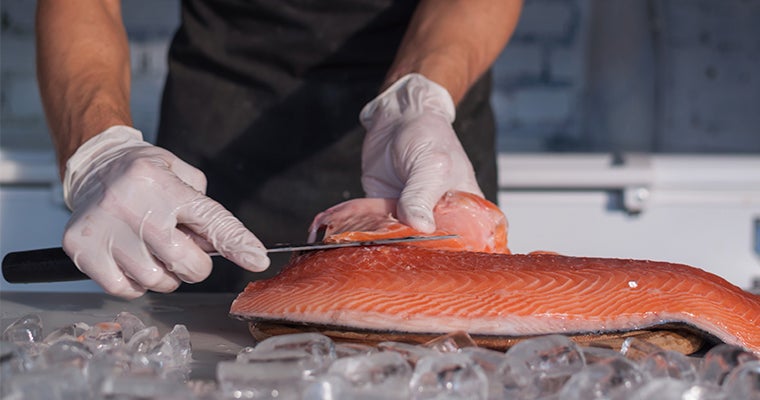A guide to sustainable and responsible sourcing.
Everyone loves a good origin story. Today’s consumers are especially interested in the origins of their food—but the story of where seafood comes from can get murky.
It’s common knowledge that seafood can either be caught in the wild or farmed. Yet this is only half the tale. Exactly how each fish and shellfish is caught or raised can have implications for sustainability and nutrition—and these factors can impact your customers’ buying decisions.
Wild-caught vs. farm-raised
Wild-caught seafood has been captured in its natural environment. The Alaska Seafood Marketing Institute notes that these fish and shellfish have a natural life cycle and feed on a natural marine diet, which is typically more diverse than what farmed fish get to eat on a regular basis.
Farm-raised seafood is born and bred in vast pens that are often submerged in ponds, lakes, rivers and oceans. The aim is to provide a fertile growing environment, such as in the cold fjords of the Faroe Islands or the warm waters at the base of the Andes in South America. To maintain product health, farmed species are not allowed to mingle with wild species and the growing areas are rotated to protect quality.
Fresh farmed seafood and frozen wild-caught seafood are available year-round. Fresh wild-caught seafood is seasonal and the supply depends on weather and water conditions.
Seafood can be sustainably sourced from the wild or from a farm. It all depends on the methods employed by the farm or fishermen.
All about seafood certifications
Consumers have long gravitated to seafood as a healthy choice. Today, they’re not just concerned about the nutritional benefits for their own bodies—they’re also taking a closer look at how their personal seafood choices are impacting the health of the planet.
Foodservice operators who assure customers about the sustainability of the seafood on their menu will appeal to the growing environmentally aware market segment. One of the best ways to provide this assurance is to menu products that meet independent sustainability standards.
These seafood certifications give diners choices they can feel good about—and give operators another way to differentiate themselves from the competition.
Look for the label
These certifications are the most commonly used methods of identifying sustainably caught or produced seafood.
- Aquaculture Stewardship Council. ASC is an independent, international non-profit organization signifying that products have been farm-raised using responsible aquaculture practices.
- Best Aquaculture Practices. BAP is a third-party aquaculture certification program identifying products that protect the quality and integrity of finfish, crustaceans and mollusks.
- Marine Stewardship Council. MSC-certified products are wild-caught and fully traceable throughout the supply chain. The MSC standard is a scientific measure of sustainable fishing.
- Monterey Bay Aquarium Seafood Watch. This science-based seafood program develops purchasing guidelines for consumers, chefs and business professionals. It includes recommendations for which seafood items are Best Choices or Good Alternatives, and which you should Avoid.
- Ocean Wise. The Ocean Wise symbol on a product or menu item certifies a sustainable seafood choice that promotes the health of oceans for generations to come. The Ocean Wise Seafood Program is used by thousands of locations across Canada.
Consider using these labels on your menu to direct guest attention to your sustainability commitment. Some guests will want to dive deeper into the details, so be sure to prepare servers with additional background.
Weigh the impact before jumping in
Identifying products by these certifications provides a greater level of transparency for operators and their customers when choosing seafood products. Keep in mind, however, that consumers don’t always modify their purchasing decisions based upon label claims or certifications. When deciding if you should incorporate a sustainability or transparency message into your brand consider the following:
- Is sustainability or transparency important to your consumers? How will your initiatives meet their needs?
- Will a sustainability or transparency initiative help drive sales with your target consumers?
- What are the operational costs and impacts to areas like food costs, staff training and marketing?
- How will you develop a plan to market your sustainability or transparency initiatives as part of your overall brand messaging?










